[Click on BLUE links for sources and information]
Most of us in Mendocino know Merlin Tinker (Barry Weiss). At Think in the Morning we were delighted to hear from Barry and to discover that he had a number of scribbles as he calls them depicting some of his experiences in times past, scribbles he is willing to share with you, our readers. Most of the scribbles are from around 20 years ago but they go back much further. These memories provide a small snapshot into Barry’s very interesting life. They are unedited but we have arranged them approximately chronologically.
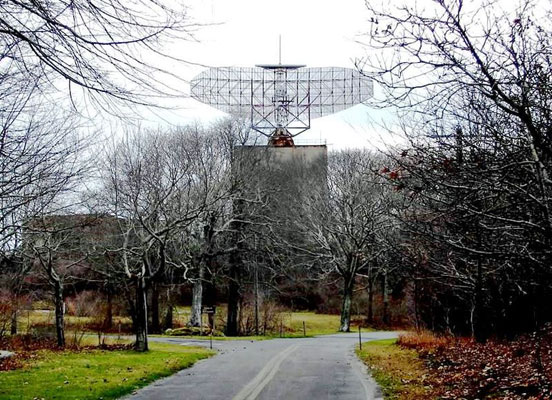
773rd Radar Squadron at Montauk Point
A little background: Barry served in the United States Air Force for two and a half years at the 773rdRadar Squadron at Montauk Point, New York before being sent to Miyako Jima, a small island 75 miles off Okinawa where he spent one year. After the Air Force Barry had a job at Pan American Airways working on Boeing-707 and DC-8 jets where he worked his way up to Senior Mechanic. Pan Am sent him to I.B.M. school to learn Computer Programming, a skill he used to design and program an Accounts Receivable system for American Express Credit Card Company. He moved on to design and install a Railroad Car Control System (RAILCON) for American Cyanide Chemical Company and later modified the system for E.I. duPont de Nemeurs and Company. He also installed a Bank Payroll System for Peoples Bank of New Jersey. He redesigned the Record System for Capitol Record Club.
None of this was known to us at the time we met Barry during our Sea Gull days. He was simply Merlin Tinker, Fixer of Sewing Machines.
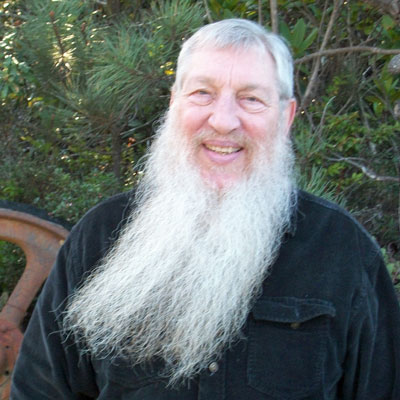
Merlin Tinker (Barry Weiss)
There Was A Time …
There was a time, when I lived in The Bronx, somewhere around age 10 or so, that I happened to be near Yankee Stadium when a game let out. Fifty thousand fans poured out onto Jerome Avenue, and there was a constant murmur among them, “Hey, seben to tree! Seben to tree. Hey, you belie’ dat? Hey, seben to tree, man.” Here were 50,000 people that could all agree on one single thing. It made no difference which was their favorite team. They could all agree on, “Seben to tree.”
There was a time, when I was about 12, that my Dad took me to Orchard Street (off Delancy) for my first grown-up suit. For $10 I got a jacket and pants; for $15, a jacket and two pants, or a jacket, vest and pants. These were all top quality suits that were sold at Macy’s or Sacks, but had some minuscule defect, such as a thread that had some red in it (indicating the end of the spool), or double stitching where it should have been single. As I grew older, I continued to buy my suits on Orchard Street. I was a Computer Programmer working as a consultant for American Express. A fellow I worked with, Vinny Sessa, came from the old school in Little Italy, and had his suits custom made from Italian Sharkskin; went through dozens of fittings to get it just right. It looked great on him. One day, he walked past one of the disk drives and caught the sleeve of his jacket, and ripped a gash in it. I asked him what he would do, and he said he’d have it re-woven, at a cost of about $200. I didn’t want to add insult to his ruined suit, so I didn’t say the first thing that came to mind: I could get ten new suits for what it would cost him to fix this one.
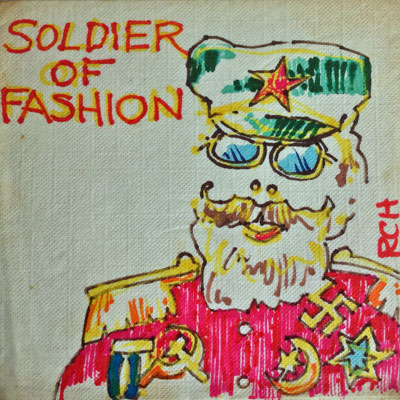
Sea Gull Cellar Bar Napkin Art, Roy Hoggard artist
There was a time, I got a job at a Bowling Alley servicing the first AMF mechanical pinsetters. Now it’s all automated, but back when I was 18, it was the first step above having people set the pins back up. AMF was the first machine to do it, but very soon Brunswick came out with an improved version. I never worked on Brunswick, but I got to know the AMF very well.
I worked there for maybe a year, after school each day. That was after I spent a year at a TV repair shop, and another year at an upholstery shop. All of this was after school.
One day the owner asked me if I would want to paint a fresh coat of polyurethane on the alleys. It’s clear, but very hard when it dries. It has to withstand a bowling ball being dropped on it a thousand time a day. So I started painting; and I got sweated up from all the bending down and getting up to move a little and bending down again. I got so hot, I took my t-shirt off. Then my chest started to burn. I went to the john and washed my chest with cold water, and let out a scream; it hurt so much. I went home, and tried a hot shower, but that wasn’t any better. Because I was sweating, the pores opened up, and that polyurethane paint got absorbed into my skin. That was my last day at the bowling alley; I quit.
I guess I wasn’t smart enough to read the label on the polyurethane paint. It said to use only with adequate ventilation. There wasn’t any ventilation. Had that happened today, when I’m a lot older and wiser, I could have sued the owner for putting me in a perilous situation. By the next day, I was okay again, but I didn’t want to work there any more.
There was a time, when I was in the Army in 1956, I was stationed in Fort Bliss, Texas (it wasn’t bliss). Part of our training was to be sent out on guard duty. I was driven out into the middle of the Guadalupe Desert, New Mexico, given a rifle without bullets, a canteen and a knife. I was out there guarding a Radar Van, in the middle of absolutely nowhere. The sky at night was magnificent. I’ve never seen so many stars! But, while standing outside at night admiring the stars, something crossed my path of vision. It scared me. After many days, I figured out it was a Kangaroo Mouse. They’re cute little things with oversized rear legs that can hop to a height taller than me.
There was a time, when I enlisted in the Army (1956). I was sent to Ft. Knox, Kentucky for basic training. There must have been a thousand of us on a troop train that left Penn Station, and arrived the next morning in Louisville. We all poured off the train and began looking for food. The Army doesn’t have catering service on their cattle cars. Someone spotted a restaurant in the Louisville station, and the thousand of us headed for it. One of the guys spotted a “No Colored” sign on the door. Since the trainful was all Army and half “Colored,” we all bypassed the restaurant and headed out to the base where we were served by soldiers that didn’t care what color our skin was. The food might not have been as fancy as at the Louisville Station, but we had all we could eat. That one little sign on the restaurant door cost them thousands of dollars from just that one train alone.

There was a time, when I was 20. I was in the Air Force, stationed at Montauk Point Air Force Station, the eastern tip of Long Island, NY. It was 1959. This is before transistors. Before Stereo. Before 8-track tape. I found an article in Popular Mechanics magazine called, “Sweet Sixteen.” It was not about girls. It was the complete plans on building a speaker for my HiFi.
I had lots of time, and at Montauk, nowhere to spend my pay. So I bought 16 each 6″ speakers, and a sheet of plywood. The result was 16 tweeters and a bass speaker 48″ by 48″.
Each of us on the base had our own room in the barracks. I had a record changer and a tube amp, and played mostly classical music. Someone brought me a dead clock-radio. I tore the clock out of the case, and connected it to my turntable-changer. At night, I’d load a stack of 12″ records in the changer, start the changer into the reject cycle, and turn the clock to Alarm mode. At 7:00 in the morning, the clock would click, the first record would drop, and I’d be awakened gently by “Swan Lake” or “The Dance of the Sugarplum Fairies”.
One of the guys in the barracks, I never found out whom, sneaked into my room one night and changed the record and the volume on the amp and the time on the clock. At 4:00am, I was awakened by “Victory at Sea,” Side 2, the Shelling of Okinawa Beach by 16″ cannon, at full volume. There were 80 guys running frantically through the building wearing helmets, shower clogs and jockey shorts, trying to find someone with the key to the rifle locker, as we were surely under attack.
The Sweet Sixteen had terrific bass response.
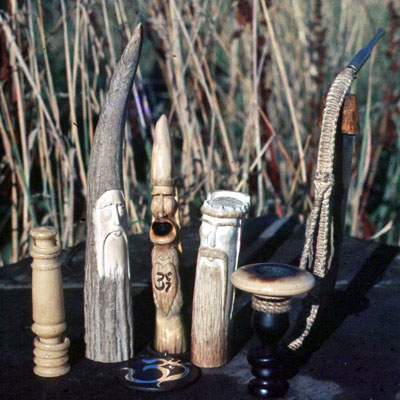
Barry’s Carvings
There was a time, 50 years ago, when I was in the Air Force, stationed on a tiny, very remote island in the East China Sea. We had radio communications with Okinawa, a much larger island. We received a radar report of a very large storm, a Typhoon, coming our way, and were ordered to batten down all the buildings; place steel shutters over all the windows. Well, we were prepared, and had the steel shutters in place long before the impending storm. So we went around outside the base to warn the natives that a storm was coming. One of the farmers said, “Storm no come. Snail still crawl.” The storm completely missed us.
There was a time, when I had been in the Air Force for almost four years, that I was returning from a one year tour on a remote Island in the East China Sea. We flew from Okinawa to Honolulu, and were able to de-plane and stretch our legs . Everyone made a bee line across the tarmac for the facilities. It was a huge wooden building with years of graffiti scratched on the walls. The urinal that I happened to be standing in front of had graffiti carved very deeply into the wall,
“I am too shoddy a specimen to create anything of worth.
But I can deface, and this proves: I, too, have been.”
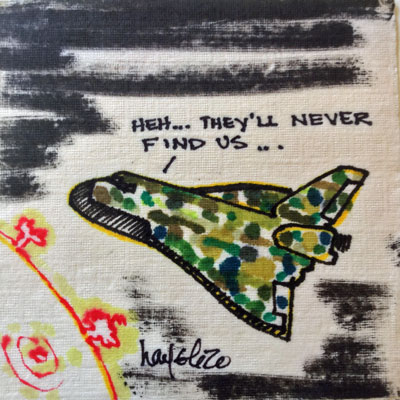
Sea Gull Cellar Bar Napkin Art, Jack Haye artist
There was a time, when I got out of the Air Force in 1962. I found a job with Pan American Airways. I was hired to fix Radio & Radar in the Boeing 707’s & DC-8’s. While Pan Am hired me on the spot, I couldn’t start work for them until I joined a union; AFL-CIO. Pan Am was a union shop.
There were 50 of us on a crew. We worked a week of days, a week of swings, a week of mids, and a week off. There were 2 guys that did Radios (me included), 2 guys that mopped the plane, 2 guys that changed engines, etc. A plane would come in with some notes that the Captain had written in the log; this wasn’t working, and that was sluggish. Those 2-guy crews were sent out to fix it. But most of the time, the junior of the 2 guys went out, and the senior hung out in the lounge. When I asked how come they didn’t go out to fix the plane, I was told that it’s a union shop, and they can’t be fired. So they goofed off their entire shift and got paid well for it.
Then I heard of the same thing happening in Detroit. The unions would go on strike for higher wages and fewer working hours. When they settled the strike, and went back to work, they just hung out in the lounge and goofed off. Cars were rolling off the line on which the wheels would fall off, or missing a battery, or a windshield. The guys responsible couldn’t be fired, so they did nothing each day beyond punching in on the clock and punching out at the end of the day. Then they got the junior-most guy to punch in for 20 or 30 of them, and they didn’t even have to come to work.
The cars coming from Japan had everything in the right place and they worked fine. Americans began buying Japanese cars and shunning Detroit cars.
There was a time, that I was living in New York City on 24th Street and 2nd Ave on the 12th floor. I heard a knocking on my window (no fire escapes), and looked out to see a golf club reaching down from the 14th floor (no 13). He invited me up to a party. He was celebrating. He had gotten a job with a Wall Street Broker as the assistant to the assistant broker. That means he goes out for coffee and cigars. He had graduated from a Jesuit college in upstate N.Y. He was so proud of himself having gotten a job on Wall Street that he called the Dean of the college to tell him. The Dean asked him to find a decent growth stock, which he did after asking his boss. He called back the Dean, who said, “Buy me $10 million dollars worth.” He did. When he went to work the next day, his desk was missing. He asked the secretary, who said he has a new office. On the door was his name, and “Director of Institutional Sales.” He bought us a couple of tickets to Bermuda to celebrate. I don’t even remember his name. It was 1962 or ‘63. He had just made $200,000 as his broker’s fee.
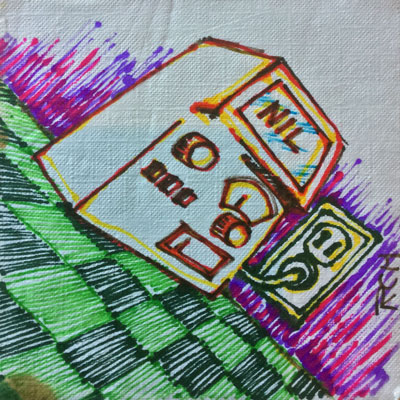
Sea Gull Cellar Bar Napkin Art, Roy Hoggard artist
There was a time, when I worked for a programming consulting firm. I was paid an annual salary, and told that I would never get overtime. Sometimes I worked eighteen hours a day, sometimes twenty, and sometimes seven days a week for months at a time. Not for overtime did I do this, but for the zest that creating a program, one that had never been done before, could bring to me. It was akin to creating a symphony, or an oil painting, or sculpture. A one-of-a-kind, first-kid-on-the-block feeling, a self-generated pat on the back from the inside. But the boss saw me working myself to death, and decided to help me along, telling me that the deadline was moved ahead, or that a special program was needed by yesterday at the latest; a program that had been written many times by many other people, and could have been gotten for a phone call. Gone was the zest. Now I was dancing someone else’s steps, to someone else’s music, and no longer got the pat on the back from the inside, and especially not from the outside.
I quit, dropped out, walked from New York, and kept walking for a year. Life was only walking, staring ahead, not looking ahead. There was no goal, no objective, only a way of life to get away from, a city to leave. Along the road I met people, many people. They had woes of their own, troubles, and gadgets that stopped working. Sometimes I would fix one of their gadgets, and watch their face light up, and joy replace the defeat they felt. From their joy, I received some measure of happiness, and also satisfaction. I started offering to fix things for people, and with each success would come some of the old pat on the back from the inside. I had found a new source of the fountain of youth.
For the forty-eight years that I have been in this area, people told their friends about this magical tinker who likes to fix things. I have been retired from the “real” working world for all this time, but have consistently earned my living by my pleasure. My “living” is an economic livelihood, and a spiritual “raison-d’être” that is so necessary to survival. If I don’t feel good about myself and what I do for others, then I am not enthused about doing anything for anyone, and become reclusive and depressed. When I first came to this area I spent a winter in a redwood stump. My flame had gone out, not the one in the fire-pit, but the one in my soul. Re-kindling that flame was a slow process. Walking or running may generate endorphins which elate the spirit, but nothing is as uplifting to the soul as helping someone else.
Somewhere in the midst of my back is an invisible hug-button. This button may be triggered by a warm hug and a hearty “thanks,” offered freely by a person other than myself. I’ve searched for this button on my own back, but to no avail. Only another person is capable of pressing my hug button. This button stays active for quite awhile, and the more often pressed, the longer it remains turned on. Helping others helps me recreate myself. Helping people smile helps me smile. Giving to others of my time returns to me my soul, my reason for being.
There was a time, I once worked on a computer program for the Washburn Wire Drawing Mill in Harlem, on the East River. Ten-foot rolls of 2-inch thick wire were delivered in 7-ton rolls. The mill would draw the wire down, thinner and thinner. Each time the wire was drawn through a plate with a slightly smaller hole than the size of the wire at the time, it would stretch in length as it decreased in width. It would also get springier. This company made springs of all sorts from this wire.
There came the day when they tried to figure out what to charge for a small spring. They figured that they’d have to know how many times the wire had been drawn down, and how many times it had been handled or moved. They had a very difficult time trying to track the wire. That’s when they contacted our computer programming company.
Our idea was to have a bunch of multipart tags printed, with a wire-tie attached to the tag. The tags were combinations of colors, so we could follow the wire through it’s different processes. When the 7-ton roll was delivered, a red-&-white tag was attached. When the roll went through its first process, the punch-card part of the red-&-white tag was torn off and sent to the computer room, while a red-&-brown tag was attached next to the stub of the red-&-white one. There would be a different color combo for each process.
It took more than a year to write the computer program, and when we were ready, we sent the computer operator (their employee) into the computer room alone, with typed instructions describing which color combo box of tags were to be mounted into the computer printer. We were sure we had covered every contingency. When the program started, we watched the operator through the glass from outside the computer room. He stood there quite confused without doing anything. Finally we poked our heads into the room and asked if the instructions were not clear. He pointed to the instructions and asked, “What color is red?”
(He was color-blind)
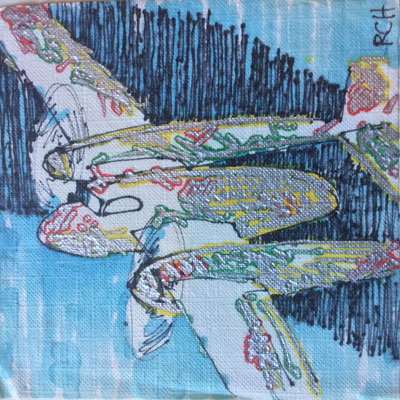
Sea Gull Cellar Bar Napkin Art, Roy Hoggard artist
There was a time, in 1964, that I was a computer programmer for Pan American Airways. I was stationed at Idlewild Airport, which had not yet been renamed JFK International. The IBM-1440 was in the basement of the Pan Am Terminal, so occasionally, I’d go upstairs on my breaks and talk with the Ground Stewardesses. One day while we were talking, a plane from Europe landed, and all the passengers poured off the plane on their way to Baggage Claim. A couple stopped next to the Stewardess I was speaking with and asked, “Should we see the Grand Canyon in the morning and the Statue of Liberty in the afternoon, or the other way ’bout?”
There was a time, that I first started with Pan American (1962). I was assigned to work on their Boeing-707 and DC-8 aircraft. I repaired or replaced the various radios and radars that they had on these planes. I did that for 7 months, when I found a notice for an exam to be given for a Computer Programmer. No one knew what that was, but 2,700 employees signed up for the exam; mostly because it was a day off with pay.
It’s a long story how it came to be that I passed the test, and was sent to IBM programming school in Manhattan. When I finished school, and was sent to work on their IBM-7080 monster machines in dreary Long Island City, they wanted me to calculate the payroll. They had timecards for each employee showing the number of hours worked for that week. I’d have to match the employee number with the base salary for that employee, multiply that out, calculate any overtime, if any, and add that in, calculate taxes, withholding, etc., then print payroll checks two-up in the line printer.
This printer was capable of sustained 1,200 lines per minute. It was so fast, that nothing today could match it. It sucked up paper from a box at the base, and spit it out the back so that it stacked itself in another box.
Then, after a few months of successfully doing Inventory and Payroll, they switched me to another position. They sent me out to Idlewild Airport (now JFK International) and showed me the Aircraft Load Control room. It was in the basement of the Arrivals/Departure building. The room was maybe 25’x25′, and had about a dozen people working in it. There were no windows, just fans. Hanging on the wall were hand-written charts, one for each airplane that would fly that day. People called in to make reservations, sometimes a year in advance, and their reservations were written on this chart for this flight. Three people for Flight-0002 to Puerto Rico. There were reservations offices around the world in every city, but they all connected by phone to this room in the basement.
The day of the flight, people would show up at the airport. They would walk to a Passenger Check-In counter, and be greeted by a Ground Stewardess. They were asked if they wanted a specific seat. The Ground Stewardess picked up a handset, which rang directly to the basement room without dialing. The Stewardess would tell the controller which flight number, and wait until they walked to that part of the wall. Then the Stewardess would tell the controller which seat these three people to Puerto Rico wanted, and the controller would mark off those seats on the chart, and the Stewardess would write the seat numbers on the tickets.
That’s all well and good. But, according to the FAA regulations, a list of the passengers’ names and seat assignment had to be provided to the FAA officer before a flight was allowed to take off, so all the names on the charts had to be typed by hand into seat-number order, and the typed sheet hand delivered down the hall to the FAA officer. Only then could the Pilot get permission to leave the gate. This was so that if the plane crashed, they knew whose charred body was in which seat.
Okay; that’s how it was. Pan Am wanted to upgrade this somehow now that they had this IBM-1440, which cost them more than a million dollars. So, I was assigned the job. The best job in the world a young lad could ever have lucked into. My job was to take a Ground Stewardess to lunch, paid for by the company, and have her tell me all the things she did when a passenger showed up. This was followed every day with a different Stewardess, until I had spoken with them all.
From all the info I gathered, I designed a remote terminal to be custom-built by IBM, and tied into the computer in the basement. This box had a 4″x4″ green-screen monitor, and a keyboard that was a square block with 1-5 on the top row, 6-0 on the second row, ABCDE on the third row, etc. We didn’t want any speed typists, as the computer would be dealing with many Stewardesses at a time. It wasn’t multi-tasking, but I made it work that way. There would be a dozen of these terminals all around the Departures Building.
So, now, the same passengers come in to go to Puerto Rico, the same Stewardess greets them, takes their tickets, and punches in the 4-digit flight number, then the first two letters of their last name. The screen responds with up to eight passengers whose last name starts with those two letters. The Stewardess punches a number between 1 to 8 corresponding to the passengers’ name on the ticket. If the first 8 names aren’t it, she punches a zero, and another 8 names pop up.
The Stewardess shows the passengers a picture of the plane, and asks where they’d like to sit. She punches this in, and the seats are assigned.
Next passenger, please.
The list is sorted, and much more info on the passengers is provided to the FAA (address, phone number), and long before takeoff at that.
And the best part, is that the Load Controllers that worked in the basement don’t have to be there anymore. They can work in daylight.
So, that’s the first major program I wrote.
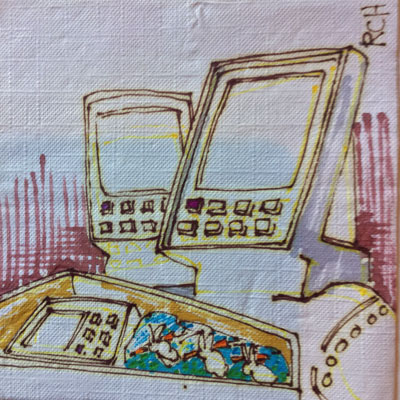
Sea Gull Cellar Bar Napkin Art, Roy Hoggard artist
There was a time, forty years ago, I was in Sausalito, living on someone’s houseboat at Gate 6. Everywhere I went, I’d see stoned hippies pestering people with “Spare change?” Most people responded with, “Ga’wan! Geddatta heah! Beadit! Geddada my face! Go getta job.” One day, just for a lark, I stood outside Swenson’s Ice Cream Parlor on Bridgeway (the main drag), and as people walked by, I’d smile and say, “Spare change for Ice Cream?!?” Almost everyone stopped dead in their tracks, thought for a moment, and said, “Ice Cream? You want Ice Cream? Listen, I’m on a diet, so here’s five dollars. Go have a big Ice Cream on me.” Some of the people looked at me a little funny, took me inside, and had me order what I wanted, and paid for it, lest I use the money to buy beer, which is what they all assumed I’d do. I had more Ice Cream in one day than I’d had at any other time in my life, but besides the Ice Cream, I got $54 cash. That being 30 years ago, that $54 would be the equivalent of $540 today. Not bad for a day’s panhandling.
There was a time, in the early ‘70s that a sign was seen from the 101 freeway in San Rafael: “Surplus.” I don’t think many people got off the freeway to visit the store. One day a new sign appeared above the original sign. It wasn’t bigger, but everyone noticed it, and many cars then signaled for the exit. “The Winter of our Discount Tent.”
There was a time, I remember watching the six o’clock news, one evening during the Viet Nam war. Jimmy Breslin was relating the body counts coming out of the war, and noted that there were also counts of bridges that had been destroyed. He read the number with great emphasis, “50,000! 50,000 bridges destroyed! 50,000 bridges!… We don’t have 50,000 bridges in America, much less in Viet Nam. The only way we could destroy 50,000 bridges in Viet Nam is if we send over two waves of B-52s. The first wave drops bridges, and the second wave bombs them.”
There was a time, when I first arrived in Mendocino, I was a bearded long-haired Hippy. There were dozens of us that had arrived in the late Sixties-early Seventies. I tried being friendly with the locals as I passed them on the street, and said, “Good morning!” I rarely received an answer.
One morning, while having coffee at the old Sea Gull, I was staring up Lansing Street, and realized I was looking at a large, black mushroom cloud over the Church at the top of the hill. I called over the waitress and told her I think that’s a fire, then went running up the hill to do what I could. I dragged some tires away from the building and turned off the electricity, doing anything I could that I thought would help.
A few minutes later the town Fire Siren went off, and pretty soon a fire-truck arrived. Having no experience fighting a fire, I backed away from the building to let the firemen at it. As each fireman arrived, he would grab a hose off the truck and run with it until he got to where he was to use it. I stood well clear. But then I noticed that the last hose was being wrestled with by an old man, and he wasn’t getting it off the truck. I approached and asked if I could help. It was Dell Schlaffer, then about 85, who told me he had just got out of the hospital. So I grabbed the hose and ran with it. When they turned the water on for me, I thought I was going to be knocked over; all that water pressure in a 2″ hose.
I watched the other firemen to see what they did, and tried to keep my section watered down as they did theirs.
After the fire was contained, I returned to the Sea Gull to pay for my coffee, and then returned home to Caspar.
When I got into Mendocino the following morning, all those locals that I had greeted without success for all that time, were along the street, and as I passed, each greeted me, by name, very warmly.
I guess I had passed some ritual initiation into the town’s society.
There was a time, that a Health Food store opened at the corner of Simpson Lane and the Highway (now the State of the Ark Thrift Store). It was called Earthly Delights, and sold only pre-packaged wares. An entire isle was devoted to Teas. Apparently, when they first opened, they put out an entire case of Earl Grey, Sleepy Time, Red Zinger, etc. As time went by, some of the teas were sold, and new boxes were put on the shelf to replace the ones sold. After three years, it was obvious which were the new teas and which hadn’t been disturbed, as a light coating of dust covered the older boxes. The cleanest, most recently replaced boxes were “Women’s Libber-Tea,” and the dustiest, never-been-touched was “Back To Reali-Tea.”
There was a time, that the McCormack Center for the Healing Arts (Peter Barg, MD & Jacques Tenzel, MD) was moving from Mendocino to Caspar. They had purchased the old Caspar Compound on Pacifica and called for a crew of volunteers to help refurbish the place, the work to be done over the July 4th weekend. A hundred and fifty people showed up to help, most of them contractors whose fingers Peter had sewn back on. I was doing electrical wiring, and Jacques came over to say that he was going into town for supplies, and was there anything I needed? I told him I needed more reds and yellows. He looked at me very oddly and said, “Barry, do you take those?” I couldn’t figure out what he was asking, and he, a psychiatrist, was just as dumbfounded. I finally showed him the reds and yellows I was talking about, they’re plastic caps to screw over the junction of two or more electrical wires, and he slapped his head, and without saying anything else, walked off. I got my reds and yellows when he came back. It was years later that I found out what Downs Poppers are, and the drugs they ingest (Seconal & Nembutal).
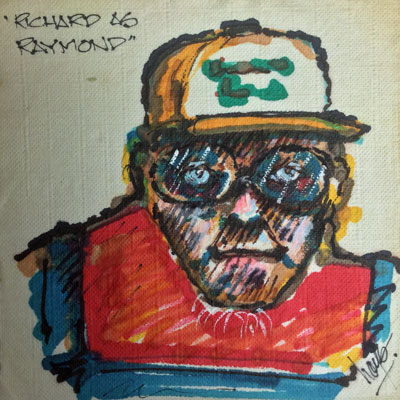
Sea Gull Cellar Bar Napkin Art, Jack Haye artist
There was a time, about forty years ago, that Raymond Hee stood around on Main Street every day wearing bib overalls, a baseball cap and a Junior G-Man badge. He had a small spiral notebook and the stub of a pencil. Although it was difficult to tell, Raymond was afflicted with Down Syndrome. He was thirty years old outside, and three years old inside. He would look at all the tourists walking the streets, and when he spotted one of the locals whom he recognized, he’d pull out his little spiral notebook and pencil, walk up to the local and say, “I’m gonna give ya a ticket for bein’ barefoot,” and start making squiggly lines on the paper. If the local engaged him in conversation, he’d make more squiggly lines. Finally, he’d say, “Here’s your ticket,” and hand him the paper covered in squiggly, meaningless lines. It was at that same time that the town of Mendocino was, for the first time, trying to incorporate, attempting to wrest control from the County seat in Ukiah. There was a meeting at someone’s house on Jackson Street, during which the lawyers were reading off, from a list, what a town is required to have in order to incorporate. Water treatment plant, Fire Department, Police Department… Everything stopped. Mendocino had no Police Department. Doctor Harold Robinson spoke up, “I nominate Raymond Hee as the Police Department.” Pharmacist Morris Boynoff said, “I second the motion with the condition that no one tell Raymond.”
There was a time, that I took Myrtle Johnson out for breakfast at the Café Beaujolais to celebrate her eighty-fourth Birthday. The waitress brought her a cup-cake with a candle in it, and Myrtle was happy. After breakfast we went back to her house in Caspar and sat on her front porch enjoying the sunshine. I asked her, matter-of-factly, where she had been in her long life. Myrtle got all excited, and breathlessly exclaimed, “Oh! Oh! I’ve been to Willits. Twice!!” (40 miles away)
There was a time, when the Bank of America had a branch in Mendocino (now the “Out of This World” shop). The bank was well appointed, with redwood counters and brass footrails. There came a time that an ATM machine was to be installed, and a glass wall was built to separate the bank, which closed at three pm, from the ATM which was to always be available. A person using the ATM, however, had their back to the entrance-way, and many complained of feeling vulnerable. So the bank installed a lock on the outer door that was operable only by an ATM card. Late one night, one of the locals walking their dog passed the bank and observed someone inside the bank, asleep in a sleeping bag, with a back-pack alongside. They called the Sheriff, who rousted the bank manager, who came to unlock the door. When the Sheriff nudged the sleeper, and demanded to know what he was doing there, a hand emerged from the sleeping bag holding an ATM card.
There was a time, the Mendocino Hotel was bought by R. O. Peterson, who made his fortune selling Jack-in-the-Box franchises. He put a lot of money into fixing up his newly acquired hotel, and had the windows boarded up with plywood while they worked on the interior. Just about the time he opened for business, there was a pushcart out front that sold tacos and burritos. The name on the pushcart was “Juanito En Cajon.” Loosely translated, that’s “Little Jack in the Box.”
There was a time, when I lived in Caspar, about 30, maybe 35 years ago, Frank Johnson had a herd of 20 or 30 cows in three different fields, and 3 bulls. Besides the bulls freshening the cows in Caspar, Frank would rent them out to service other herds in Cleone and Albion. I went with Frank on some of his trips. He was getting on in years and wouldn’t admit that he could use any help, but I went anyway.
Frank would drag this little trailer/wagon, and hook it up to the tow ball on his pickup, and back the wagon to the gate of whichever field had the bull he was going to rent out (only one bull to a field). It was always a hassle getting the bull roped, and dragging it reluctantly into the wagon, and tying it in. It was always a hassle with any of the bulls besides Curly. Curly had one regular horn, and one that curled like a corkscrew.
When Frank backed the wagon to the gate of the field that held Curly, we didn’t have to do anything other than open the tailgate on the wagon. Curly would bellow from the other side of the meadow, and run full tilt right up the ramp and into the wagon, then stand there patiently while we put the tail-gate up and got moving. Curly figured out where he was going, and what he was going to do when he got there.
I’ll miss Curly. I’ll miss Frank too. He passed away at 96, still wrestling cows to the end.
There was a time, when I was on the Big Island of Hawaii in 1991. I went around to look at the lava flows there. The volcanoes had been burbling and bubbling for years, but none of it looked like the gigantic eruptions of Indonesia. On Hawaii, the lava just flows along, eventually reaching the ocean; creating a lot of steam.
Getting anywhere near the lava is dangerous. There were tourists that tried to walk on the lava, and their shoes melted, and then their feet melted. They won’t ever walk on anything again! They’re lucky they’re still alive.
There was a flow of lava that was heading for a small community near the ocean. The lava had been flowing in that direction for five years. Half the people in the community called in house movers, jacked up their houses, and moved them to a special area set up for them, and guarded. The houses were piled right next to one another; no one lived in them. But the houses that hadn’t been moved were still lived in. The people looked out their back door every day, and watched the lava slowly approaching, and said, “No way the lava will reach us. We’re safe.”
Well, the lava finally reached the houses, and as the back porch caught fire, the owners frantically tried getting all their favorite possessions rounded up and tried to save what they could. They were frantic. They had five years advance warning. Five years!!! But they waited till the last minute to panic and gather their stuff.
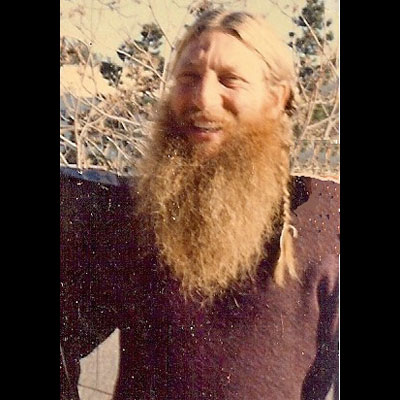
Merlin Tinker (Barry Weiss) in Israel in 1985
There was a time, way back in the mid 1980s, when IBM made the first Desktop computers, that the chip, which was made by Intel, was called an 8086. Then Intel came out with a faster chip, which they called an 80286. People became familiar with the names of the chips, and most people dropped the “80” from the name, and referred to them as 286. Then Intel came out with the 386, faster still. A new company, AMD, came out with the same chip, and called theirs a 386 also. Intel had the 486 in development, and went to the Trademark Board in Washington to attempt to trademark the number “486.” The Trademark Board threw them out with the terse comment, “If my house number was 486, would I have to pay you royalties?” So Intel came out with the 486. But when it came time for the next version, instead of calling it a 586, they were crafty enough to call it a Pentium.
When they made that announcement, I cracked up laughing. What would they call the next one, a Hexium or a Sexium? Sure enough, they figured out their own same dilemma, and called the next one a Pentium-II, then a Pentium-III. They still haven’t figured out what to do next.
There was a time, that I smoked cigarettes. One evening, I decided to quit smoking. So I went out for a walk and threw away the factory made cigarettes. I bought some rolling tobacco and some rolling papers. I figured I would roll my own, and take a giant puff, and hold it in as long as I could. That was to be my ration for the day; one huge puff per day. It was a weird idea.
I got up in the morning, rolled a cigarette (it was very sloppy), sat on the edge of the bed, lit it, took a huge puff and held it in. Meanwhile, I stubbed out the cigarette so that I wouldn’t be tempted to get another puff. The next thing I knew, I was picking myself off the floor, having passed out. Inside, I felt like I was 13 again and just getting my first inhale. It was like I time-tripped. Something about that overdose of cigarette smoke brought my mind back to my first teenage inhale.
I stuck to my resolution, and didn’t have another puff that day.
The next morning, I did the whole thing again. A newly rolled cigarette, but this time I propped myself up on the bed, back against the wall, so I couldn’t fall off if I passed out. I took an enormous puff, and held it in while stubbing out the cigarette in the ashtray. I’m sure I passed out again, but this time there was no flashback.
There never was a third day or a third puff. I never had another puff of a cigarette. That was 40 years ago. I never had a desire to smoke again. Anytime I was near anyone who was smoking, it would sicken me, and I’d move away from them. I felt like I had never smoked, and it was disgusting to me to be near anyone who was smoking.
I had smoked cigarettes for about 20 years before I quit that day in 1974.
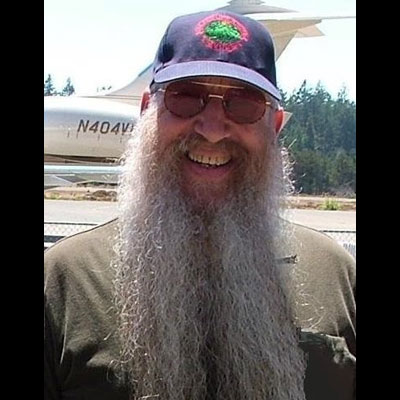
Merlin Tinker (Barry Weiss)
There was a time, forty-seven years ago, that I showed up at the door of a house in town with a bar of soap, a bottle of shampoo and a towel. I was shown to the shower, and told to use all the hot water I needed. A lot of the houses in town each had a line at their front door consisting of grungy looking souls with towels. I had spent the winter in a Redwood stump 3 miles out Little Lake Road in Jackson State Forest. The Redwood stump had a small stream running through it into which I could dip a cup for drinking water. There was just enough room inside the stump to almost stretch out in my sleeping bag, which was laid out over a board that covered the stream. It was a very rainy winter, so I didn’t venture into town often. But when the rain stopped, after a three-month continuous downpour, I was ready for a change of clothes and headed into town to get clean.
There was a time, when I first got to Mendocino, I was told there was a hippy restaurant called The Pyewacket, next door to the BofA. It looked like a private house. The only sign outside was a tiny strip of paper above the doorbell that said Pyewacket. I didn’t want to ring the bell, as it might have been someone’s home. Just then a few hippies came out and confirmed my suspicion. I had been on the road, and was broke and hungry. I went to ask if I could do some work in exchange for breakfast. They gave me a pail with hot soapy water, a sponge and a squeegee. I went to the nearest window, and found that it still had a ring of moisture around the outside edge where it had been washed 10 minutes before I got there. I washed all the windows again, and was served a delicious breakfast.
There was a time, I got a call. I answered it on my landline phone. Spoke for maybe ten minutes, finished, and hung up.
Strangely, the Caller ID continued to say “TELEPHONE IN USE.” I lifted the handset, and hung it back up. I tried all of the other handsets in the house. Nothing seemed to fix the problem. The phone was screeching and saying, “If you want to make a call, hang up.”
I went outside and dismantled the rats-nest of wires in the minuscule telephone junction box. Separated all the wires and cleaned and redid the connections. Went inside and according to the Caller ID, the phone was still in use. I disconnected the landline handset, and that fixed everything; the CID no longer said “IN USE.” But when I plugged in the landline, there was an immediate connection. I was frustrated. I had worked on this for over an hour.
I lifted the entire landline box, and saw nothing wrong. Then I lifted the handset, and there was a shiny paperclip, keeping the handset from completely hanging up.
Well, at least I cleaned up the telephone junction box. And got some fresh air. And practiced a few curse-words. And got some exercise running inside and out and in again. And practiced a few more curse-words.
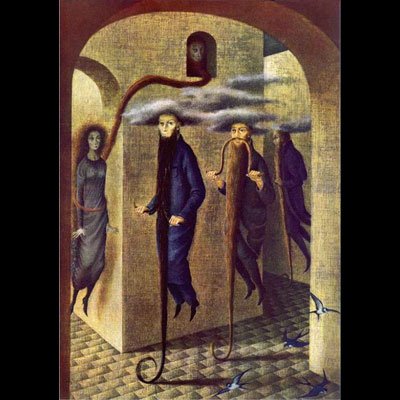
Harry Locomotion by Remedios Varo, Barry Weiss collection
“I own the Hairy Locomotion painting by Remedios Varo, and am still trying to fly with my beard.” Barry

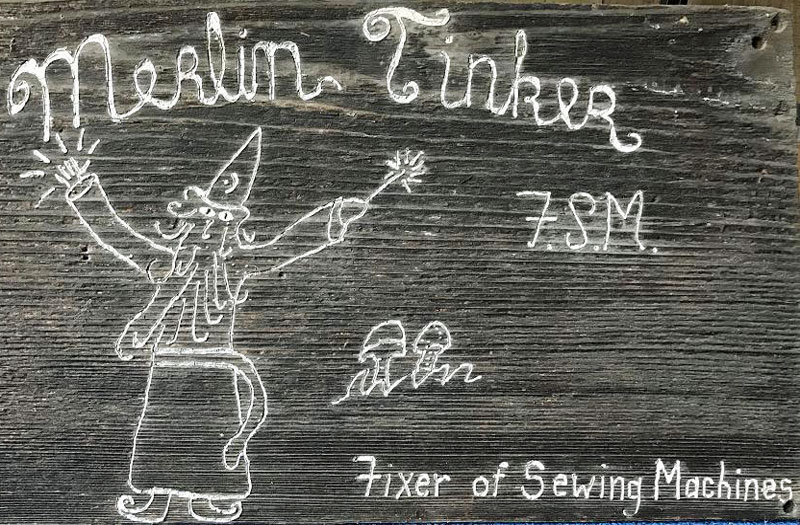
WONDERFUL!
Great work Barry!
Great scribbles.
What wonderful stories! Thank you, Tinker!
I remember some of these stories that he told me!
Yep, that’s my friend. 🙂
Wonderful to read such colorful events in your life! Thank you so much for sharing all of them!
a wonderful trip down memory lane, told with witty observance!
What wonderful, colorful stories Merlin. Allen sez hi and that he is happy to have met you. Let your soul shine, as it should, because you are a wonder to behold.
Thanks Mary. It’s a pleasure hearing from you. Hi to Alan.
Truly, one of Mendonesia’s ‘National Treasures’.
Thank you for these wonderful memories, Barry. So very interesting and real. So well written. I will be out there to visit you soon. Looking forward to more stories………
Love,
Eva
Hi Barry!
Are you related to Lawrence Weiss and Charlotte Lax? Maybe also Arlyne?? Then we share some DNA as my maiden name was Weiss! Would love to be able to contact you for a chat.
Some how your name came up in an internet search. I think I needed to repair something-anyway-I knew you in the seventies, there in Caspar, just thought I would say hello, can’t believe I found you on the web after all these years. I hope you are well
I’m so happy you reached out.
Not sure if this is David or Barry responding, if it’s David please send Barry my regards.